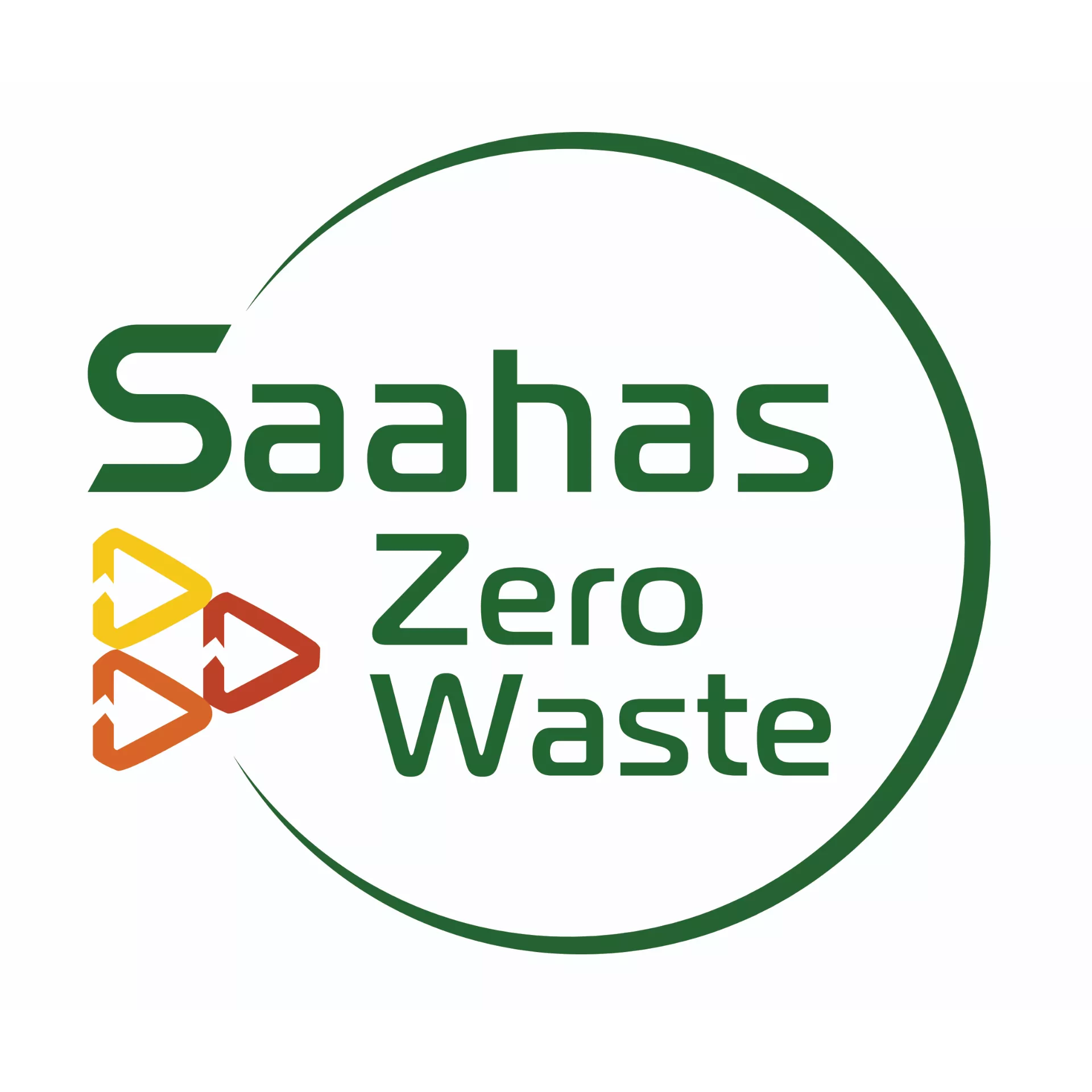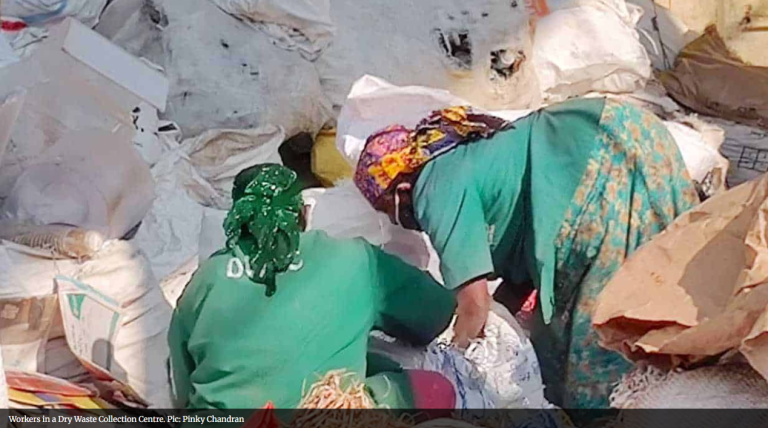Written by Annie Philip
Introduction
India generates approximately 8 million tons of textile waste annually, much of which ends up in landfills or incinerators, depleting natural resources and contributing to environmental pollution and climate change. To address this issue, Concordia Textiles, Enviu, and Purfi under the develoPPP funding programme implemented by GIZ India on behalf of Federal Ministry for Economic Cooperation and Development (BMZ) , have been working since 2021 to demonstrate an inclusive and circular value chain for textile waste in India. Saahas Zero Waste (SZW) has partnered to develop a training curriculum, teaching aids, and conduct 50 training programs for 3000 waste workers, among other activities in the project. These training programs aim to equip waste workers with the knowledge and skills to efficiently handle and sort textile waste, promoting environmental sustainability and economic opportunities.
Developing Teaching Aids
Before commencing the training programs, the SZW team developed teaching aids based on the Textile Waste Management Methodology (TWMM) created by Enviu and SZW. These aids were designed to provide waste workers with the tools necessary to address the challenges of sorting and recovering textile waste. The teaching aids included contextualised content, easy-to-understand designs, and a mix of textual and visual cues tailored for informal waste workers, municipal waste workers, and workers employed by solution providers. The aids comprised illustrations, graphics, flowcharts, Do’s and Don’ts, photographs etc while the delivery methods included posters, videos, practical demonstrations, physical samples, and kit cards. Feedback from SZW project managers and staff was incorporated to refine the content, and the aids were translated into Kannada, Hindi, and Tamil for broader accessibility.

Mapping Training Clusters and Training the Trainers
The 50 training clusters were selected based on:
- Existing connections with municipalities and informal waste worker colonies due to SZW’s operations.
- Interest from municipalities in improving textile waste management.
- Focus on large cities with high textile consumption and disposal rates.
- Locations with other GIZ projects to ensure synergies.
- Locations of solution providers for cross-learning and capacity building.
The SZW team undertook participant mapping, logistical planning, and developed training plans and agendas for the training programs. They also established feedback mechanisms to ensure continuous improvement as the training programs progress across different parts of India. Clusters were developed in Karnataka, Tamil Nadu, Delhi NCR, Uttar Pradesh, Uttarakhand, Maharashtra, and Assam, to ensure pan India coverage. These clusters included municipalities, informal waste worker colonies and facilities of solution providers working with municipal solid waste (including textile waste). In addition, SZW team collaborated with other organisations such as EcoSattva, Chintan (Environmental Research and Action Group), ITC WOW, and Dharmalife for training workers engaged by them.
To ensure uniform training quality, SZW conducted two trainer trainings. The first involved a site visit to the Enviu Textile Sorting Centre in Chennai to understand operations and sorting processes. The second was a classroom-style training at the SZW Textile Waste Recovery Facility (TRF) in Bengaluru. Trainers learned sorting techniques, fabric tests, and other processes and these details were provided in Kannada, Tamil, and Hindi to accommodate trainers working in various regions.
Overview of the Training Programs
The primary goal of these training programs was to introduce waste workers to textile waste management, raising awareness about the types of textile waste and broad sorting techniques. The training aimed to change waste workers’ perspectives, encouraging them to view textile waste as a valuable resource that can be upcycled, repurposed, and recycled. Enhanced capabilities were expected to help municipalities, solution providers, and informal workers manage significant textile waste, recover valuable resources, and generate dignified livelihoods.

The training programs followed a pre-set agenda, adaptable to circumstances where the the trainers could modify it if there were extraneous circumstances during the training programs. They began with an introduction to the project “Building an inclusive and circular value chain for textile waste in India,” detailing its funding, implementing partners, and objectives. An icebreaking activity followed, where participants shared their experiences with textile waste, setting the stage for deeper discussions on the textile industry elements, such as fibre, yarn, fabric, and apparel.
The training covered sorting methods for both post-production and post-consumer textile waste, however, the focus during most of the training programs was on post-consumer textile waste given that the waste workers typically handle this waste and not post-production waste. In any event, the participants learned to identify and differentiate between these waste types using posters, samples, and group discussions. For post-production waste, the criteria for sorting and contaminant removal were explained, along with fabric construction types and colour and size sorting techniques. In the context of post-consumer waste, the distinction between re-wearables and non-wearables was highlighted, emphasising the importance of brand tags in the resale market. Under the collaboration with Dharmalife – a not-for-profit organisation develops entrepreneurship models that provides rural communities the opportunity to earn a livelihood such as training women as tailors and creating a market for the products created by these women, SZW trained the women tailors on the upcycling of tailoring scrap waste and other textile waste.

The participants engaged in hands-on demonstrations of flame and odour tests to understand fabric compositions, learning to distinguish materials like cotton, polyester, wool, silk, and nylon. The training included a colour sorting activity, illustrating the importance of sorting textile waste by colour and size for recycling purposes. After the training, the SZW team also obtained feedback from the participants, to map the efficiency of the trainings, needs of the workers and what can be improved in the training programs.
A total of 53 training programs were conducted across all zones of the country: North, South, West, and East. The programs saw participation from 3003 waste workers, including 1985 municipal workers, 537 informal workers, and 481 workers from sustainable solution providers. Women dominated the trainings, making up 53% of the attendees, while men accounted for 47%.
Key Findings
- Lack of Prior Training: None of the participating waste workers had previously received training on textile waste management. The project training programs were their first exposure to this critical aspect of waste management, highlighting their initial low to non-existent baseline knowledge.
- Infrastructure Challenges: Municipal workers emphasised the need for separate infrastructure for textile waste collection and aggregation. The current system, with only two sections in the collection vehicle, risks contaminating textile waste. Additionally, there is no dedicated aggregation space for textile waste at storage facilities, even if collected separately.
- Workload Concerns: Municipal workers are already overburdened, limiting their ability to engage in textile waste sorting. However, understanding the environmental impact of unmanaged textile waste motivated many to consider sorting if mandated by authorities and if there is financial gain from the process.
- Informal Sector Insights: Informal waste workers also expressed concerns about the additional workload if textile waste sorting becomes mandatory. Yet, they showed willingness to participate if there is financial value.
- Economic Incentives: Both formal and informal waste workers showed strong interest in the financial benefits of handling textile waste during the training programs. Many questions focused on the market viability and financial gains from selling sorted textile waste.
- Upcycled Products from Textile Waste: Several waste workers expressed keen interest in upcycling textile waste and learning to make products from it. Future trainings on upcycling should be considered to skill waste workers, manage textile waste, and generate revenue.
- Hands-On Activities: Participants engaged in practical activities such as identifying different types of textile fibres using flame tests and sorting textiles based on colour, type, and size. Feedback indicated strong interest in these activities, highlighting the success of combining theoretical knowledge with engaging, hands-on learning experiences.
- Informal Worker Engagement: Engaging informal workers was challenging due to their focus on immediate income and unpredictable work hours. Future strategies should include financial incentives or immediate value propositions to enhance their participation.
- Market Linkages: The absence of established large-scale markets and recycling facilities for sorted textile waste hindered the immediate adoption of new sorting techniques. Developing market linkages and end destinations for textile waste is crucial for sustained engagement and capacity building.
- Awareness and Capacity Building: Continuous awareness programs and capacity-building initiatives are essential to maintain interest and participation of waste workers in sustainable textile waste management. Leveraging existing networks and success stories can motivate more workers to engage in textile waste management.

Conclusion
The training programs successfully introduced textile waste management concepts to a diverse group of waste workers, highlighting the environmental and economic benefits. While challenges remain, especially in engaging informal workers and developing market linkages and infrastructure around collection, sorting and recycling textile waste, the willingness of participants to learn and adapt is promising. Training programs such as these have the potential to be a pivotal step towards sustainable textile waste management, fostering circularity and inclusivity in India’s textile waste value chain.
Source link : View Article
Author
-

Saahas Zero Waste is an environmental and social enterprise with +20 years of experience in waste management, resource recovery and social impact. Saahas Zero Waste was registered as a Pvt Ltd Company in 2013. Its mother organisation, NGO Saahas was established in 2001.







